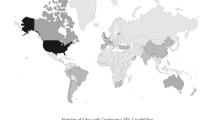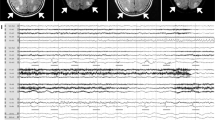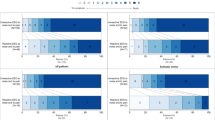Abstract
Background/Objectives
Epileptiform abnormalities (EA) on continuous electroencephalography (cEEG) are associated with increased risk of acute seizures; however, data on their association with development of long-term epilepsy are limited. We aimed to investigate the association of EA in patients with acute brain injury (ABI): ischemic or hemorrhagic stroke, traumatic brain injury, encephalitis, or posterior reversible encephalopathy syndrome, and subsequent development of epilepsy.
Methods
This was a retrospective, single-center study of patients with ABI who had at least 6 hours of cEEG during the index admission between 1/1/2017 and 12/31/2018 and at least 12 months of follow-up. We compared patients with EAs; defined as lateralized periodic discharges (LPDs), lateralized rhythmic delta activity (LRDA), generalized periodic discharges (GPDs), and sporadic interictal epileptiform discharges (sIEDs) to patients without EAs on cEEG. The primary outcome was the new development of epilepsy, defined as the occurrence of spontaneous clinical seizures following hospital discharge. Secondary outcomes included time to development of epilepsy and use of anti-seizure medications (ASMs) at the time of last follow-up visit.
Results
One hundred and one patients with ABI met study inclusion criteria. Thirty-one patients (30.7%) had EAs on cEEG. The median (IQR) time to cEEG was 2 (1–5) days. During a median (IQR) follow-up period of 19.1 (16.2–24.3) months, 25.7% of patients developed epilepsy; the percentage of patients who developed epilepsy was higher in those with EAs compared to those without EAs (41.9% vs. 18.6%, p = 0.025). Patients with EAs were more likely to be continued on ASMs during follow-up compared to patients without EAs (67.7% vs. 38.6%, p = 0.009). Using multivariable Cox regression analysis, after adjusting for age, mental status, electrographic seizures on cEEG, sex, ABI etiology, and ASM treatment on discharge, patients with EAs had a significantly increased risk of developing epilepsy compared to patients without EA (hazard ratio 3.39; 95% CI 1.39–8.26; p = 0.007).
Conclusions
EAs on cEEG in patients with ABI are associated with a greater than three-fold increased risk of new-onset epilepsy. cEEG findings in ABI may therefore be a useful risk stratification tool for assessing long-term risk of seizures and serve as a biomarker for new-onset epilepsy.

Similar content being viewed by others
References
Hill CE, Blank LJ, Thibault D, et al. Continuous EEG is associated with favorable hospitalization outcomes for critically ill patients. Neurology. 2019;92:e9–18.
Rodriguez Ruiz A, Vlachy J, Lee JW, et al. Association of periodic and rhythmic electroencephalographic patterns with seizures in critically ill patients. JAMA Neurol. 2017;74:181–8.
Tabaeizadeh M, Aboul Nour H, Shoukat M, et al. Burden of epileptiform activity predicts discharge neurologic outcomes in severe acute ischemic stroke. Neurocrit Care. 2020;32:697–706.
Zafar SF, Postma EN, Biswal S, et al. Effect of epileptiform abnormality burden on neurologic outcome and antiepileptic drug management after subarachnoid hemorrhage. Clin Neurophysiol Off J Int Fed Clin Neurophysiol. 2018;129:2219–27.
Husari KS, Johnson EL, Ritzl EK. Acute and long-term outcomes of lateralized rhythmic delta activity (LRDA) versus lateralized periodic discharges (LPDs) in critically ill patients. Neurocrit Care. 2020. https://doi.org/10.1007/s12028-020-01017-y.
Punia V, Bena J, Krishnan B, Newey C, Hantus S. New onset epilepsy among patients with periodic discharges on continuous electroencephalographic monitoring. Epilepsia. 2018;59:1612–20.
Punia V, Fitzgerald Z, Zhang X, et al. Electroencephalographic biomarkers of epilepsy development in patients with acute brain injury: a matched, parallel cohort study. Ann Clin Transl Neurol. 2019;6:2230–9.
Tubi MA, Lutkenhoff E, Blanco MB, et al. Early seizures and temporal lobe trauma predict post-traumatic epilepsy: a longitudinal study. Neurobiol Dis. 2019;123:115–21.
Banerjee PN, Filippi D, Allen Hauser W. The descriptive epidemiology of epilepsy: a review. Epilepsy Res. 2009;85:31–45.
Punia V, Garcia CG, Hantus S. Incidence of recurrent seizures following hospital discharge in patients with LPDs (PLEDs) and nonconvulsive seizures recorded on continuous EEG in the critical care setting. Epilepsy Behav. 2015;49:250–4.
Punia V, Vakani R, Burgess R, Hantus S. Electrographic and clinical natural history of lateralized periodic discharges. J Clin Neurophysiol Off Publ Am Electroencephalogr Soc. 2018;35:71–6.
Alvarez V, Rodriguez Ruiz AA, LaRoche S, et al. The use and yield of continuous EEG in critically ill patients: a comparative study of three centers. Clin Neurophysiol Off J Int Feder Clin Neurophysiol. 2017;128:570–8.
Hirsch LJ, LaRoche SM, Gaspard N, et al. American Clinical Neurophysiology Society’s Standardized Critical Care EEG Terminology: 2012 version. J Clin Neurophysiol. 2013;30:1–27.
Bentes C, Martins H, Peralta AR, et al. Early EEG predicts poststroke epilepsy. Epilepsia Open. 2018;3:203–12.
Kim JA, Boyle EJ, Wu AC, et al. Epileptiform activity in traumatic brain injury predicts post-traumatic epilepsy. Ann Neurol. 2018;83:858–62.
Struck AF, Ustun B, Ruiz AR, et al. Association of an electroencephalography-based risk score with seizure probability in hospitalized patients. JAMA Neurol. 2017;74:1419–24.
Naidech AM, Beaumont J, Muldoon K, et al. Prophylactic seizure medication and health-related quality of life after intracerebral hemorrhage. Crit Care Med. 2018;46:1480–5.
Klein P, Dingledine R, Aronica E, et al. Commonalities in epileptogenic processes from different acute brain insults: Do they translate? Epilepsia. 2018;59:37–66.
Reid AY, Bragin A, Giza CC, Staba RJ, Engel J Jr. The progression of electrophysiologic abnormalities during epileptogenesis after experimental traumatic brain injury. Epilepsia. 2016;57:1558–67.
Andrade-Valenca LP, Dubeau F, Mari F, Zelmann R, Gotman J. Interictal scalp fast oscillations as a marker of the seizure onset zone. Neurology. 2011;77:524–31.
Vespa PM, Shrestha V, Abend N, et al. The epilepsy bioinformatics study for anti-epileptogenic therapy (EpiBioS4Rx) clinical biomarker: study design and protocol. Neurobiol Dis. 2019;123:110–4.
Vespa P, Tubi M, Claassen J, et al. Metabolic crisis occurs with seizures and periodic discharges after brain trauma. Ann Neurol. 2016;79:579–90.
Haapaniemi E, Strbian D, Rossi C, et al. The CAVE score for predicting late seizures after intracerebral hemorrhage. Stroke. 2014;45:1971–6.
Struck AF, Osman G, Rampal N, et al. Time-dependent risk of seizures in critically ill patients on continuous electroencephalogram. Ann Neurol. 2017;82:177–85.
Struck AF, Tabaeizadeh M, Schmitt SE, et al. Assessment of the validity of the 2HELPS2B score for inpatient seizure risk prediction. JAMA Neurol. 2020;77:500–7.
Funding
No grant support was received from any funding agency for this work in the public, commercial, or not-for-profit sectors.
Author information
Authors and Affiliations
Contributions
Dr. Monica B. Dhakar has full access to all of the data in the study and take responsibility for the integrity of the data and the accuracy of the data analysis. All authors contributed to the concept and design. Polly Kumari, Julia Lega, Denise F. Chen and Monica B. Dhakar contributed to the acquisition, analysis, or interpretation of data. Denise F. Chen and Monica B. Dhakar contributed to the drafting of the manuscript. All authors contributed to the critical revision of the manuscript for important intellectual content. Monica B. Dhakar contributed to the statistical analysis.
Corresponding author
Ethics declarations
Ethical Approval
Emory University Institutional Review Board and Grady Memorial Hospital Research Oversight Committee approved the study and granted waiver of consent.
Conflict of interest
Denise F. Chen reports no disclosures. Polly Kumari reports no disclosures. Hiba A. Haider receives consultant support from Ceribell, Inc., author royalties from UpToDate, Inc. and Springer Publishing. Andres Rodriguez has participated in an education symposium sponsored by Neuropace Inc and has financial stake at Rodzi LLC. Julia Lega reports no disclosures. Monica B. Dhakar has received honoraria for consultancy from Adamas Pharmaceuticals and research support from Marinus Pharmaceuticals, UCB Biopharma for clinical trials. She also receives funding from NIH for work unrelated to this project.
Additional information
Publisher's Note
Springer Nature remains neutral with regard to jurisdictional claims in published maps and institutional affiliations.
Rights and permissions
About this article
Cite this article
Chen, D.F., Kumari, P., Haider, H.A. et al. Association of Epileptiform Abnormality on Electroencephalography with Development of Epilepsy After Acute Brain Injury. Neurocrit Care 35, 428–433 (2021). https://doi.org/10.1007/s12028-020-01182-0
Received:
Accepted:
Published:
Issue Date:
DOI: https://doi.org/10.1007/s12028-020-01182-0




